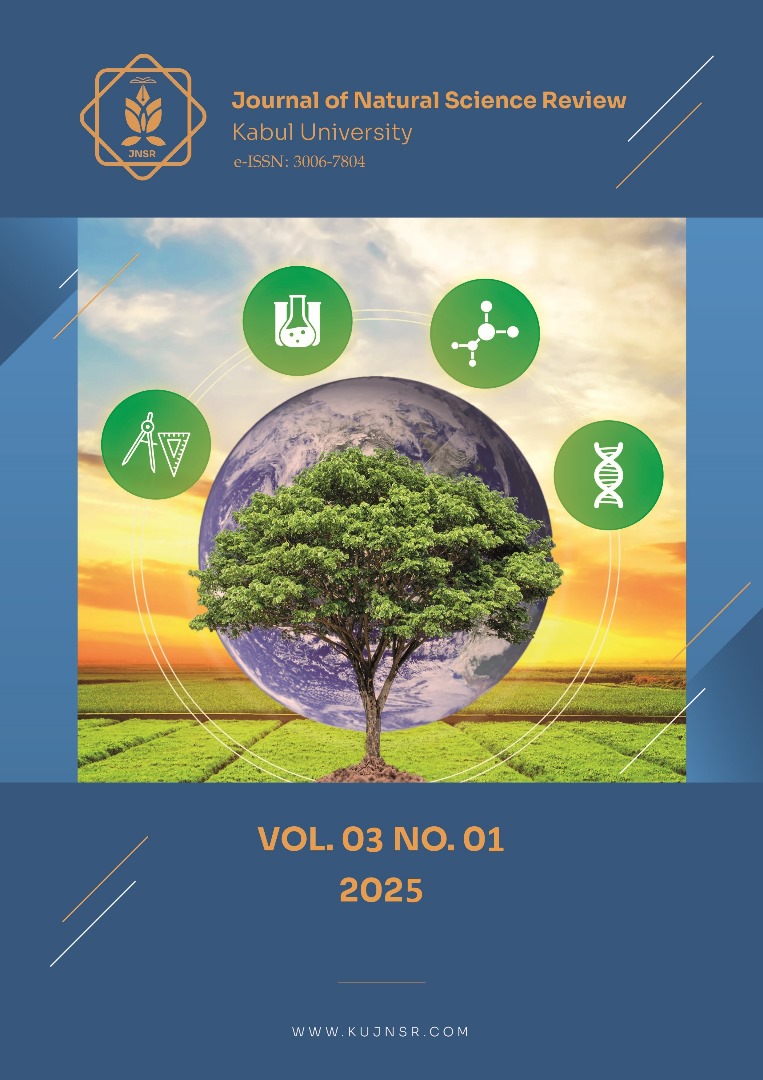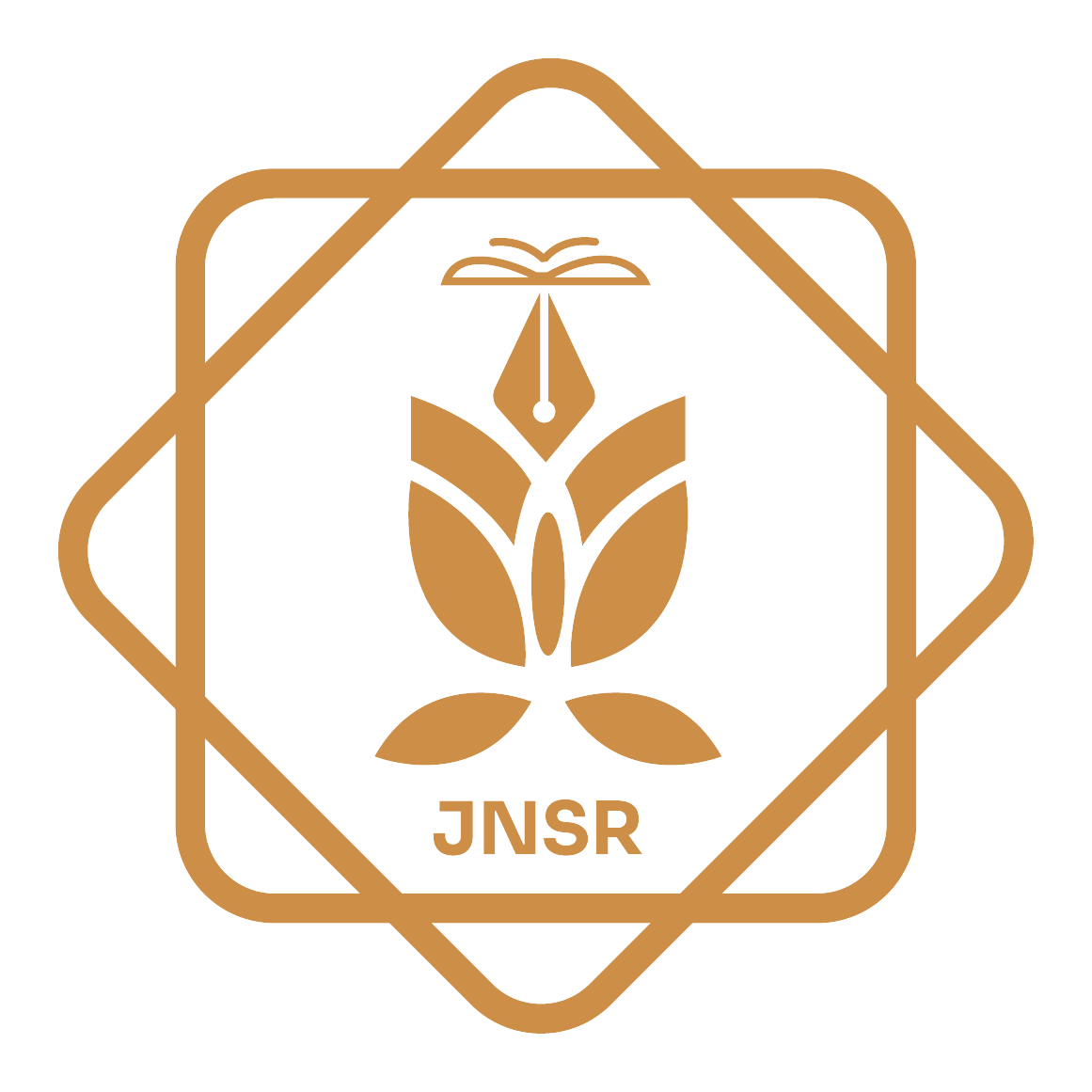Assessment of Climate Change Impacts on Streamflow in the Maidan Sub-River Basin
DOI:
https://doi.org/10.62810/jnsr.v3i1.180Keywords:
Climate change, Maidan SRB, Precipitation, Streamflow, SWAT modelAbstract
Climate change severely affects water resources in arid and semi-arid regions, including Afghanistan's Maidan Sub RB, which has been identified as highly vulnerable due to limited WR. The 2012 Global Adaptation Index ranks Afghanistan among the countries most susceptible to climate change, particularly regarding river flow changes. This study analyzes the Maidan River's streamflow using the Soil and Water Assessment Tool (SWAT), specifically at the Tang-i-Sayedan station, to forecast future streamflow under climate change conditions. The study projects a significant decline in streamflow of approximately 12.54% to 21.23% by the century's end, posing significant challenges to agricultural water supply in a region reliant on irrigation. This underscores the critical relationship between climate variability and local environmental factors, highlighting the necessity for adaptive management strategies for the region's hydrological dynamics. Therefore, policymakers must prioritize sustainable water management practices incorporating climate predictions and actively engage local communities in adaptation efforts. This approach will enhance Afghanistan's resilience to climate change, ensure water availability, and support sustainable agriculture, ultimately protecting livelihoods for future generations.
Downloads
References
Akhtar, F., Awan, U. K., Borgemeister, C., & Tischbein, B. (2021). Coupling remote sensing and hydrological model for evaluating the impacts of climate change on streamflow in data-scarce environments. Sustainability, 13(24). https://doi.org/10.3390/su132414025
Akhtar, F., Borgemeister, C., Tischbein, B., & Awan, U. K. (2022). Metrics assessment and streamflow modeling under changing climate in a data-scarce heterogeneous region: A case study of the Kabul River Basin. Journal of Water (Switzerland), 14(11). https://doi.org/10.3390/w14111697
Ahmad, M., & Wasiq, M. (2004). Water resource development in Northern Afghanistan and its implications for Amu Darya basin (No. 36) https://hdl.handle.net/10986/14939
Akhundzadah, N. A., Soltani, S., & Aich, V. (2020). Impacts of climate change on the water resources of the Kunduz River Basin, Afghanistan. Climate Journal, 8(10). https://doi.org/10.3390/CLI8100102
Bromand, M. T. (2015). Impact assessment of climate change on water resources in the Kabul River Basin, Afghanistan. Biomass and Bioenergy, 49(23–6), 135.
Dibike, Y. B., & Coulibaly, P. (2005). Hydrologic impact of climate change in the Saguenay watershed: Comparison of downscaling methods and hydrologic models. Journal of Hydrology, 307, 145–163. https://doi.org/10.1016/j.jhydrol.200
Fricko, O., et al. (2017). The marker quantification of the Shared Socio-economic Pathway 2: A middle-of-the-road scenario for the 21st century. Global Environmental Change, 42, 251–267. https://doi.org/10.1016/j.gloenvcha.2016.06.004
Fu, B., Merritt, W. S., Croke, B. F. W., Weber, T., & Jakeman, A. J. (2019). SC. Environmental Modelling and Software. https://doi.org/10.1016/j.envsoft.2018.12.008
Jawid, A., & Khadjavi, M. (2019). Adaptation to climate change in Afghanistan: Evidence on the impact of external interventions. Economic Analysis and Policy, 64, 64–82. https://doi.org/10.1016/j.eap.2019.07.010
Lawler, J. J. (2009). Climate change adaptation strategies for resource management and conservation planning. Annals of the New York Academy of Sciences, 1162, 79–98. https://doi.org/10.1111/j.1749-6632.2009.04147.x
Martin, S. (2010). Climate Change, Migration, and Governance. Global Governance: A Review of Multilateralism and International Organizations, 16(3), 397-414. https://doi.org/10.1163/19426720-01603008
Mujeeb, M., Safi, L., & Mirzazada, A. (2024). Comparison of Newton Raphson – Linear Theory and Hardy Cross Methods Calculations for a Looped Water Supply Network. Journal of Natural Science Review, 2(2), 75–90. https://doi.org/10.62810/jnsr.v2i2.40
Mishra, V., Bhatia, U., & Tiwari, A. D. (2020). Bias-corrected climate projections for South Asia from Coupled Model. Scientific Data, 1–13. https://doi.org/10.1038/s41597-020-00681-1
Mujeeb M. Sahak, K., Safi L., Ahmadzai M R. (2023). Climate Change Impacts and Surface Water Accessibility Analysis in the Ghorband Sub River Basin, Afghanistan 3(01)105-122. KPU International Journal of Engineering & Technology. https://www.researchgate.net/publication/377597943.
Ministry of Energy and Water. (2020). Energy and water policies in Afghanistan. Ministry of Energy and Water. https://www.mew.gov.af/energy-water-policie
Nguyen, T. P. L., et al. (2016). Perceptions of present and future climate change impacts on water availability for agricultural systems in the western Mediterranean region. Water, 8(11). https://doi.org/10.3390/w8110523
O'Neill, B. C., et al. (2017). The roads ahead: Narratives for shared socio-economic pathways describing world futures in the 21st century. Global Environmental Change, 42, 169–180. https://doi.org/10.1016/j.gloenvcha.2015.01.004
Ougahi, J. H., Karim, S., & Mahmood, S. A. (2022). Application of the SWAT model to assess climate and land use/cover change impacts on water balance components of the Kabul River Basin, Afghanistan. Journal of Water and Climate Change, 13(11), 3977–3999. https://doi.org/10.2166/wcc.2022.261
Reshma, C., & Arunkumar, R. (2023). Assessment of impact of climate change on the streamflow of Idamalayar River Basin, Kerala. Journal of Water and Climate Change, 14(7), 2133–2149. https://doi.org/10.2166/wcc.2023.456
Stehr, A., Debels, P., Romero, F., & Alcayaga, H. (2008). Hydrological modelling with SWAT under conditions of limited data availability: Evaluation of results from a Chilean case study. Hydrological Sciences Journal, 53(3), 588–601. https://doi.org/10.1623/hysj.53.3.588
Sarwary, M., Samiappan, S., Saravanakumar, V., Arivelarasan, T., & Manivasagam, V. S. (2021). Climate risks, farmers perception and adaptation strategies to climate variability in Afghanistan. Emirates Journal of Food and Agriculture, 33(12), 1038–1046. https://doi.org/10.9755/ejfa.2021.v33.i12.2797
Safi, L., Safi, A. G., & Mujeeb, M. (2024). Identifying Afghanistan's Extraordinary Natural Sites for Ecotourism: A Review of Ideal Ecosystems. Journal of Natural Science Review, 2(4), 147–168. https://doi.org/10.62810/jnsr.v2i4.152
Sadid, N., Haun, S., & Wieprecht, S. (2017). An overview of hydro-sedimentological characteristics of intermittent rivers in Kabul region of the Kabul River Basin. International Journal of River Basin Management, 15(4), 387–399. https://doi.org/10.1080/15715124.2017.1321004
Safi, L. . (2025). Systematic Evaluation of Afghanistan's National Food Security and Self-sufficiency: Managerial and Strategic Perspectives. Journal of Natural Sciences – Kabul University, 6(3), 61–77. https://doi.org/10.62810/jns.v6i3.329
South, C., et al. (2015). Climate change in Afghanistan deduced from reanalysis and coordinated regional climate downscaling experiment. https://doi.org/10.3390/cli5020038
Safi, L., Mujeeb, M., Sahak, K. et al. (2024). Climate change impacts and threats on basic livelihood resources, food security and social stability in Afghanistan. GeoJournal 89, 85. https://doi.org/10.1007/s10708-024-11077-8.
United Nations Environment Programme (UNEP). (2023). Climate change 2023: Synthesis report. pp. 35–115. https://doi.org/10.59327/IPCC/AR6-9789291691647
World Bank & GFDRR. (2018). Strengthening hydro met and early warning services in Afghanistan. https://doi.org/10.1596/31059
Yeh, H. F., & Tsao, J. (2020). Hydrological response to natural and anthropogenic factors in Southern Taiwan. Sustainability, 12(5). https://doi.org/10.3390/su12051981
Zhang, L., Nan, Z., Yu, W., & Ge, Y. (2015). Modeling land-use and land-cover change and hydrological responses under consistent climate change scenarios in the Heihe River Basin, China. Water Resources Management, 29(13), 4701–4717. https://doi.org/10.1007/s11269-015-1085-9
Downloads
Published
How to Cite
Issue
Section
License
Copyright (c) 2025 Mujeebullah Mujeeb, Lutfullah Safi, Mohammad Dawod Shirzad

This work is licensed under a Creative Commons Attribution-NonCommercial 4.0 International License.



























